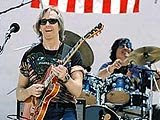As I mentioned, I play Santana's guitar parts note-for-note in my Santana Tribute Band. I've been told -- by people that have seen numerous other Santana tribute bands -- that I sound more like Carlos than any one else they've seen. To tell you the truth, I don't think it's because I'm fantastically talented. In fact, I think most people could sound a lot more like Carlos than they do. Here's what my "secrets" are.
It's All In The Timing
To me, one of the most distinctive things about Santana's guitar playing is his timing. Or, in other words, his phrasing. After all, he's mostly using the same pentatonic scales that hundreds of thousands of other guitar players use, but in his hands, they have a unique sound.
When learning Santana's parts -- especially his guitar solos, the first thing I do is to get them "in my head." That means listening to the songs actively, so that I'm actually paying attention to and absorbing all his phrasing and nuances. Because if you can't "think" it, you can't play it.
I'm convinced that all music, even the most soulful tunes, could be written out in standard notation, if you took the time. That doesn't mean it would be easy, or even that you should do it. It just means that there's nothing mysterious in what people play. It might be rhythmically complex, but it's not mystical.
In Santana's case, not only does he employ phrases that are rhythmically sophisticated, but he also anticipates or delays certain notes more than you would expect. It's part of his charm. For a great example, listen to the 1st and 2nd solos in Black Magic Woman, one of his best-known songs. The notes are as simple as can be, but the way he phrases them are priceless.
Position is Important
Once you have the phrasing in your head, experiment with the fingering until you can get the feel that he gets. Guitar is a strange instrument, in that there are often several different ways to play the same sequence of notes. Try different positions. Hint: Carlos tends to favor the higher strings -- high "E," "B," and "G," over the lower strings. And, especially in his earler material, he is not averse to using open positions.
The Little Things Matter
Pay attention to whether the notes are picked, hammered on or pulled off, and how he slides into, or away from, certain notes. One of the things I find is that the "devil is in the details." If you spend the time to capture all the nuances of Santana's guitar parts, it will make a big difference in the over all sound.
Now, I don't mean that non-musicians -- which will make up the bulk of your audience -- will come up to you after the set, and say something like "how come you played the opening riff to Oye Como Va on the 14th fret of the 'G' string? Carlos played it on the 10th fret of the 'B' string!" They won't be able to identify those details. However, they will know when it sounds like what they've heard on the radio, and when it doesn't.
Read my next post to find out why Distortion Makes a Difference.
Subscribe to:
Post Comments (Atom)


No comments:
Post a Comment